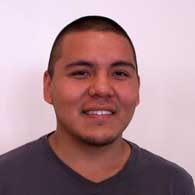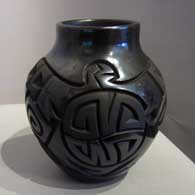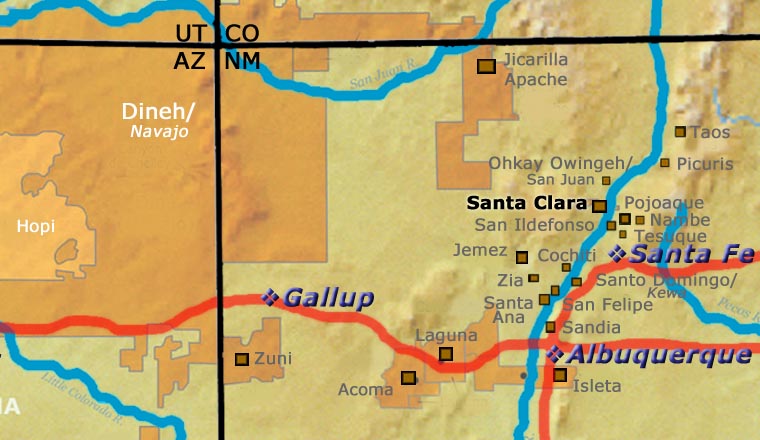
Daniel Begay
Santa Clara

Born in 1988, Daniel Begay is the son of Dineh artist Harrison Begay, Jr. His father married into Santa Clara Pueblo and became well known for his style of pottery using Santa Clara carving techniques and featuring both Dineh and Santa Clara imagery. While Daniel's work is similar to his father's, his carving is often centered along a diagonal axis and tends to be more freeform, almost like carved graffiti.
Learning the traditional method from his father, Daniel has become an excellent potter with a distinct style of his own, a merging of his personal style with traditional Santa Clara styles.
Traditional Santa Clara ground-fired pottery begins with natural red clays gathered from the hills around the pueblo. After much sifting, grinding and processing Daniel rolls the clay into long thin rolls and each pot is built by layering the rolls one on top of the other and pinching them together. This hand-coiled method includes smoothing the inner and outer surfaces by hand to attain the final shape. The pot is polished by rubbing a smooth wet stone over the piece until the red clay shines. Designs are then carved into the surface and are sometimes accented with the application of a matte slip.
Finally, if a black/brown finish is desired, the piece is fired in an “oxygen reduction” firing process which is created by smothering the fire at the right time with horse manure and ashes. The manure traps a thick, carbon-rich smoke all around the piece which fuses into the clay, turning the surface black. Red pots are created without the "smothering" part of the process.
The entire process is fraught with potential problems and for many potters, only three of every five pieces survive the firing intact. For this reason, potters often view the clay as a living entity; a finished piece is often revered as a gift from whom they often respectfully refer to as the "Clay Mother."
Daniel earned a graduate degree in accounting and another in business administration and is now employed as an academic advisor at the University of New Mexico. He is married and has a daughter, Violet. He still makes pottery in his spare time. He signs his work "Daniel" and adds the year the pot was made.
Some Awards Daniel has Earned
- 2024 Santa Fe Indian Market, the Mela Youngblood Memorial Award
- 2023 Santa Fe Indian Market, Classification II-C, Category 702 - Carved or incised, black or red, over eight inches, Second Place
- 2023 Santa Fe Indian Market, Classification II-C, Category 704 - Incised or carved, any form, Second Place
- 2020 Heard Museum Guild Indian Fair & Market, Classification II - Pottery, Division C - Carved, Native Clay, Hand Built, Fired Out-of-Doors: Second Place. Awarded for Art Work: "Bears Far & Away II"
- 2019 Santa Fe Indian Market, Classification II - Pottery, Division C - Traditional Burnished Black or Red Ware; Incised, Painted or Carved, Category 702 - Carved or incised, black or red, over eight inches: Second Place
- 2019 Santa Fe Indian Market, Classification II - Pottery, Division F - Miniature pots, individual pieces under 3" in any direction, Category 1001 - Traditional: Honorable Mention
- 2019 Heard Museum Guild Indian Art Fair & Market & Market, Classification II - Pottery, Division G - Pottery miniatures not to exceed three inches at its greatest dimension: Honorable Mention. Awarded for artwork: "Half Bear 2019 - Black"
- 2018 Santa Fe Indian Market, Classification II - Pottery, Division C - Traditional Burnished Black or Red Ware; Incised, Painted or Carved, Category 702 - Carved or incised, black or red, over eight inches: Honorable Mention
- 2018 Heard Museum Guild Indian Art Fair & Market, Classification II - Pottery, Division C - Carved, Native Clay, Hand Built, Fired Out-of-Doors: Second Place. Awarded for Art Work: "Yei Way"
- 2017 Heard Museum Guild Indian Fair & Market, Classification II Pottery, Division C - Carved, Native Clay, Hand Built, Fired Out-of-Doors: First Place. Awarded for Art Work: "Turtle Way"
100 West San Francisco Street, Santa Fe, New Mexico 87501
(505) 986-1234 - www.andreafisherpottery.com - All Rights Reserved

Santa Clara Pueblo

Ruins at Puye Cliffs, Santa Clara Pueblo
Santa Clara Pueblo straddles the Rio Grande about 25 miles north of Santa Fe. Of all the pueblos, Santa Clara has the largest number of potters.
The ancestral roots of the Santa Clara people have been traced to ancient pueblos in the Mesa Verde region in southwestern Colorado. When that area began to get dry between about 1100 and 1300 CE, some of the people migrated eastward, then south into the Chama River Valley where they constructed several pueblos over the years. One was Poshuouinge, built about 3 miles south of what is now Abiquiu on the edge of the Jemez foothills above the Chama River. Eventually reaching two and three stories high, and with up to 700 rooms on the ground floor, Poshuouinge was occupied from about 1375 CE to about 1475. Drought then again forced the people to move, some of them going to the area of Puye (on the eastern slopes of the Pajarito Plateau of the Jemez Mountains) and others downstream to Ohkay Owingeh (San Juan Pueblo, along the Rio Grande). Beginning around 1580 CE, drought forced the residents of the Puye area to relocate closer to the Rio Grande and they founded what we now know as Santa Clara Pueblo on the west bank of the river, with San Juan Pueblo to the north and San Ildefonso Pueblo to the south.
In 1598 the seat of Spanish government was established at Yunque, near San Juan Pueblo. The Spanish proceeded to antagonize the Puebloans so badly that that government was moved to Santa Fe in 1610, for their own safety.
Spanish colonists brought the first missionaries to Santa Clara in 1598. Among the many things they forced on the people, those missionaries forced the construction of the first mission church around 1622. However, like the other pueblos, the Santa Clarans chafed under the weight of Spanish rule. As a result, they were in the forefront of the Pueblo Revolt of 1680. One Santa Clara resident, a mixed black and Tewa man named Domingo Naranjo, was one of the rebellion's ringleaders. However, the pueblo unity that allowed them to chase the Spanish out fell apart shortly after their success, especially after Popé died.
When Don Diego de Vargas came back to the area in 1694, he found most of the Santa Clarans on top of nearby Black Mesa (with the people of San Ildefonso). A six-month siege didn't subdue them so finally, the two sides negotiated a treaty and the people returned to their pueblos. However, successive invasions and occupations by northern Europeans took their toll on all the tribes over the next 250 years. Then the swine flu pandemic in 1918 almost wiped them out.
Today, Santa Clara Pueblo is home to as many as 2,600 people and they comprise probably the largest per capita number of artists of any North American tribe (estimates of the number of potters run as high as 1-in-4 residents).
Today's pottery from Santa Clara is typically either black or red. It is usually highly polished and designs might be deeply carved or etched ("sgraffito") into the pot's surface. The water serpent, (avanyu), is a very common traditional design motif on Santa Clara pottery. Another motif comes from the legend that a bear helped the people find water during a drought. The bear paw has appeared on much of their pottery ever since.
Santa Clara has received a lot of distinction because of the evolving artistry the potters have brought to their craft. Not only did this pueblo produce excellent black and redware, several notable innovations helped move pottery from the realm of utilitarian vessels into the domain of art. Different styles of polychrome redware emerged in the 1920s-1930s. In the early 1960s experiments with stone inlay, incising and double firing began. Modern potters have also extended the tradition with unusual shapes, slips and designs, illustrating what one Santa Clara potter said: "At Santa Clara, being non-traditional is the tradition." (This refers strictly to artistic expression; the method of creating pottery remains traditional).
Santa Clara Pueblo is home to a number of famous pottery families: Tafoya, Baca, Gutierrez, Naranjo, Suazo, Chavarria, Garcia, Vigil, and Tapia - to name a few.
100 West San Francisco Street, Santa Fe, New Mexico 87501
(505) 986-1234 - www.andreafisherpottery.com - All Rights Reserved


